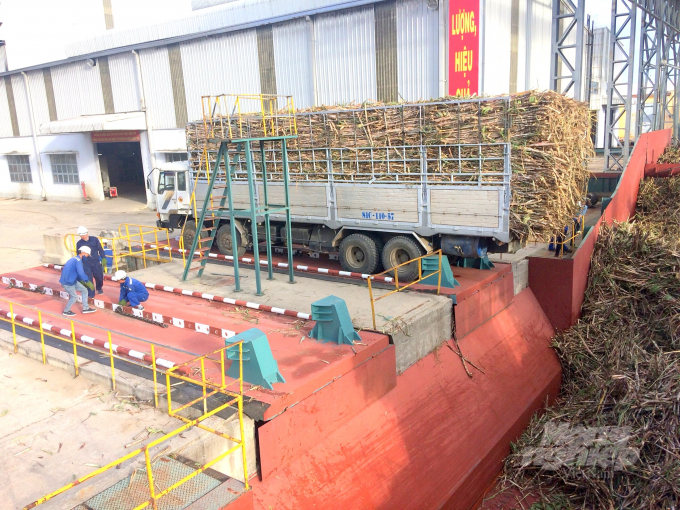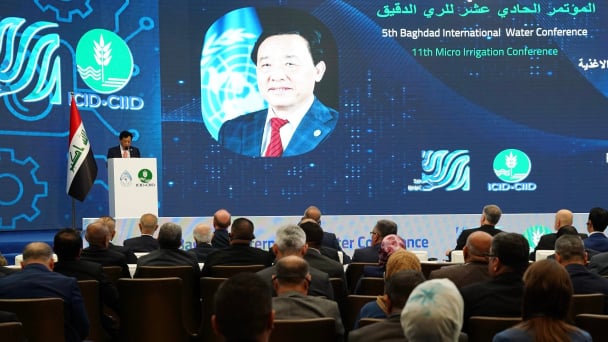June 11, 2025 | 22:32 GMT +7
June 11, 2025 | 22:32 GMT +7
Hotline: 0913.378.918
June 11, 2025 | 22:32 GMT +7
Hotline: 0913.378.918

An Khe Sugar Factory consumes about 2 million tonnes of fresh sugar cane at its peak. Photo: V.D.T.
According to Mr. Nguyen Hoang Phuoc, Deputy Director of An Khe Sugar Factory, a unit of Quang Ngai Sugar Joint Stock Company, each crop year, An Khe Sugar Factory consumes about 2 million tonnes of fresh sugar cane at its peak.
In recent years, due to fluctuations in the market and raw material areas, production activities of An Khe Sugar Factory have slowed down, and each year only has about 1 million tonnes of fresh sugarcane pressed.
In the past, when the sugar production technology of the farmers was just the cover of pressing sugarcane and cooking sugar with big pans. Bagasse has been farmed as fuel to cook sugar, or used as fertilizer for fields, used as a substrate to grow mushrooms, or as a cooking fuel for daily meals.
Since the appearance of sugar factories with modern technology, sugarcane has been able to use its benefits. The sugarcane tree produced sugar and molasses, high economic value products, and created a large amount of bagasse. Thus, bagasse is an essential by-product of the plant in sugar production.
Specifically, bagasse plays an important role when it has become a fuel source to burn boilers to serve the sugar cooking stage of sugar processing factories.
According to Mr. Nguyen Hoang Phuoc, if the sugarcane bagasse is not used to burn the boilers for sugar processing, the factory must buy electricity to operate at a high price. As a result, sugar prices will increase, reducing the competitiveness in the market.
"Every 4 tonnes of sugarcane produces 1 tonne of bagasse. At its peak, An Khe Sugar Factory consumes up to 2 million tonnes of fresh sugarcane every year, thus generating 500,000 tonnes of bagasse. However, in recent years, due to the influence of the market and raw materials, each year, An Khe Sugar Factory only runs about 1 million tonnes of fresh sugarcane, an average of 250,000 tonnes of bagasse per year.
Bagasse of An Khe Sugar Factory is used as fuel for An Khe Biomass Power Plant, a unit also under Quang Ngai Sugar Joint Stock Company, Mr. Phuoc said.

An Khe Sugar Factory consumes up to 2 million tonnes of fresh sugarcane every year, thus generating 500,000 tonnes of bagasse. Photo: V.D.T.
An Khe Biomass Power Plant, invested nearly VND 2,000 billion by Quang Ngai Sugar Joint Stock Company, officially went into operation in January 2018, has the largest capacity in the country with 95 mW and generates electricity for the national power system on the 220 kV line.
Biomass power uses biomass to generate electricity, a form of renewable energy, and has a large reserve, so many countries are interested in investing.
In the Central-Central Highlands, biomass fuels such as bagasse, sawdust, rice husks, etc., are utilized to produce electricity. Biomass power generation does not cause the greenhouse effect, does not depend on fossil fuel sources, prevents the flow of rivers, causes ecological imbalance, is not as dangerous as nuclear power. Therefore it has significantly contributed to solving the problem of environmental pollution.
Power source An Khe biomass power plant connected to the national grid has contributed to the electricity load of Gia Lai province and neighboring provinces, contributing to the country's sustainable growth goal. In addition, the biomass power plant is a solution to exploit the potential of sugarcane fully and is environmentally friendly.
With an electrical output to the national grid in 2018 of 110.7 million kWh and 97 million kWh in 2019, An Khe Biomass Power Plant has contributed to compensate for the shortage of electricity in Binh Dinh and Phu provinces. Yen in the peak months of the year.
It is an essential step in responding to the national clean energy security program. Since coming into operation, in addition to contributing to the State budget, An Khe Biomass Power Plant has also contributed to creating jobs for people, contributing to the economic and social promotion of Gia Lai province.
An Khe Biomass Power plant produces electricity from the burning of environmentally friendly organic bagasse, which is a solution to fully exploiting sugarcane's potential besides sugar production. Of the total amount of electricity produced, 20% is used to operate the sugar factory. The rest is contributed to the national grid.
"In the national power grid, biomass electricity is the cleanest source of electricity, so it has the highest price. After Quang Ngai Sugar Joint Stock Company built An Khe Biomass Power Plant, it was only then that sugarcane was fully exploited.
Sugarcane not only produces sugar and molasses but also generates electricity, improves the efficiency of machinery and equipment of An Khe Biomass Power Plant, and continues to exploit the advantages of agricultural waste in the Central region- Central Highlands", said Mr. Nguyen Hoang Phuoc, Deputy Director of An Khe Sugar Factory.
Translated by Ha Phuc
/2025/06/11/1311-5-120811_839.jpg)
(VAN) The pig farming industry is facing the challenge of comprehensive restructuring to meet requirements for quality, safety, traceability, and market expansion both domestically and for export.

(VAN) Vietnam considers participating in ALGROALBA in order to expand agricultural production, coordinate the assessment and effective exploitation potential land.
/2025/06/05/5314-1-184727_407.jpg)
(VAN) From seemingly worthless fish scales and skin, enzymes and lactic ferments can transform by-products into peptides, opening a sustainable, effective business direction and elevating Vietnamese seafood.

(VAN) TTC AgriS and IFC signed a strategic partnership to develop a sustainable agricultural value chain, aiming to achieve the Net Zero target by 2035.

(VAN) Seafood by-products are opening a new path, combining green growth and technological innovation to enhance the industry's value.

(VAN) Mr. Nguyen Thanh Cong, Vice Chairman of the Son La Provincial People's Committee, reflects on Son La’s journey from barren hills to fruitful orchards after a decade of hard work.

(VAN) FAO’s Director-General addresses the 5th Baghdad International Water Conference.